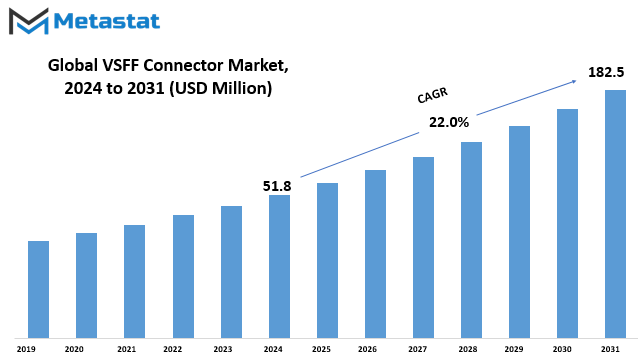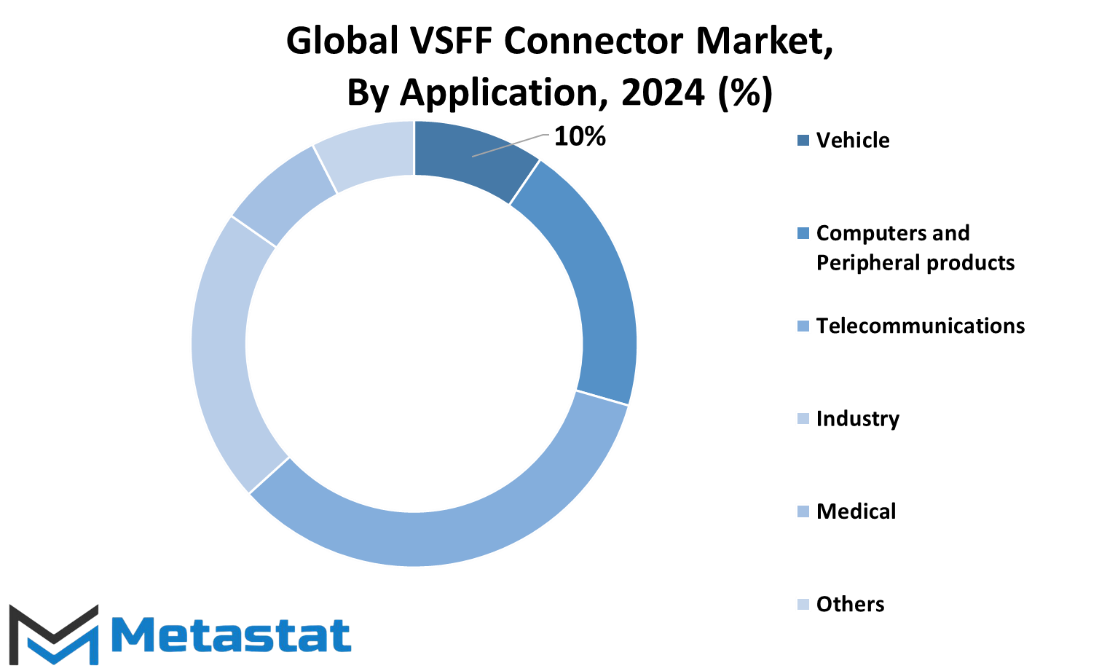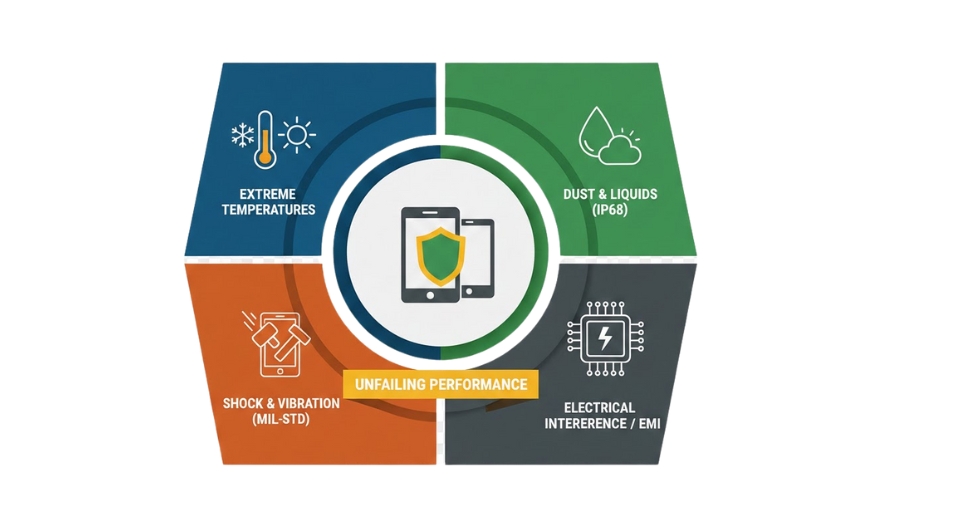MARKET OVERVIEW
The Global VSFF (Very Small Form Factor) Connector market within the electronics industry, characterized by the demand for compact, high-performance connectors across various applications. These connectors, known for their miniature size and robust functionality, play a crucial role in facilitating seamless connectivity in modern electronic devices, ranging from smartphones and wearable gadgets to medical equipment and automotive systems.
The industry surrounding Global VSFF Connectors is shaped by the ever-increasing need for smaller and more efficient electronic components. As technology continues to advance, manufacturers are constantly striving to develop products that are not only smaller in size but also capable of delivering superior performance. This has led to a surge in demand for VSFF connectors, which offer a perfect balance between size, reliability, and functionality.
One of the key drivers fueling the growth of the Global VSFF Connector market is the proliferation of portable and IoT (Internet of Things) devices. With consumers increasingly gravitating towards compact and lightweight gadgets, there is a growing demand for connectors that can accommodate the space constraints of these devices without compromising on performance. VSFF connectors, with their compact form factor and high-speed data transmission capabilities, are ideally suited to meet this demand.
Additionally, the automotive industry is emerging as a significant contributor to the Global VSFF Connector market. As vehicles become more technologically advanced, incorporating features such as autonomous driving, electrification, and connectivity, the need for reliable and space-efficient connectors becomes paramount. VSFF connectors play a vital role in enabling the seamless integration of various electronic components within modern vehicles, contributing to enhanced functionality, safety, and performance.
Furthermore, the healthcare sector represents another lucrative market opportunity for VSFF connectors. With the increasing adoption of medical devices and diagnostic equipment, there is a growing need for connectors that can withstand the rigors of medical environments while ensuring reliable data transmission. VSFF connectors, with their miniature size and robust design, are well suited to meet the stringent requirements of the healthcare industry, thereby driving demand in this sector.
The Global VSFF Connector market is a dynamic and rapidly evolving segment of the electronics industry, driven by the demand for compact, high-performance connectors across various applications. With the proliferation of portable devices, advancements in automotive technology, and the expansion of the healthcare sector, the market for VSFF connectors is poised for continued growth and innovation. As manufacturers continue to develop cutting-edge solutions to meet the evolving needs of consumers and industries, the future looks promising for the Global VSFF Connector market.
Global VSFF Connector market is estimated to reach $182.5 Million by 2031; growing at a CAGR of 22.0% from 2024 to 2031.

GROWTH FACTORS
In today's interconnected world, the demand for compact and efficient connectivity solutions continues to rise. This trend is particularly evident in the global Very Small Form Factor (VSFF) Connector market. One significant driver behind this surge is the increasing need for compact and efficient connectivity solutions in portable and mobile devices.
The proliferation of smartphones, tablets, laptops, and other portable gadgets has fueled the demand for connectors that are small and capable of delivering high-speed and reliable connections. Consumers expect their devices to be sleek and lightweight without compromising on performance, and VSFF connectors play a crucial role in meeting these expectations. These connectors enable manufacturers to design thinner and more compact devices while still ensuring seamless connectivity.
Furthermore, the rise in data center deployments has also contributed to the growing demand for VSFF connectors. As businesses and organizations worldwide continue to digitize their operations, the need for high-density, high-speed connections within data centers has become paramount. VSFF connectors offer a solution to this challenge by enabling the creation of densely packed server racks and equipment, thereby maximizing space utilization and optimizing data transfer speeds.
However, despite the promising growth prospects, the VSFF Connector market also faces several constraints. One of the primary challenges is the technical difficulty associated with maintaining signal integrity at miniaturized scales. As connectors become smaller and more densely packed, ensuring reliable signal transmission becomes increasingly complex. Factors such as signal loss, electromagnetic interference, and crosstalk pose significant obstacles that need to be overcome through innovative design and engineering solutions.
Additionally, the high costs associated with research and development (R&D) and production of miniature connectors represent another obstacle to market expansion. Developing cutting-edge VSFF connectors requires substantial investments in technology, materials, and expertise. Furthermore, the economies of scale may not always apply to VSFF connectors due to their specialized nature, leading to higher production costs per unit.
Despite these challenges, the VSFF Connector market presents several opportunities for growth and innovation. One notable opportunity lies in the expansion of the Internet of Things (IoT) and smart devices. With the proliferation of connected devices in homes, industries, and cities, there is a growing need for compact and reliable connectors to enable seamless communication between devices. VSFF connectors offer a compelling solution for connecting sensors, actuators, and other IoT devices in a variety of applications, ranging from home automation to industrial IoT.
The global VSFF Connector market is driven by the increasing demand for compact and efficient connectivity solutions in portable and mobile devices, as well as the rise in data center deployments necessitating high-density, high-speed connections. However, the market faces challenges such as technical complexities and high production costs. Nonetheless, opportunities abound in emerging technologies and applications, particularly in the IoT space, paving the way for continued growth and innovation in the VSFF Connector market.
MARKET SEGMENTATION
By Type
The global market for VSFF connectors encompasses various types, each serving specific functions within electronic devices. These connectors play a crucial role in ensuring the seamless transmission of signals and power between different components. Among the different types of VSFF connectors, the MMC, MCD, CS, and SN connectors stand out as significant contributors to the market.
The MMC connector type serves as a vital component in electronic systems, facilitating the connection between various modules and devices. Its versatility and reliability make it a popular choice in a wide range of applications. In 2025, the MMC connector segment was valued at 8.12 USD million, reflecting its importance in the market.
Similarly, the MCD connector type plays a significant role in electronic connectivity, particularly in high-speed data transmission applications. With a value of 15.6 USD million in 2025, the MCD connector segment demonstrates its relevance and demand in the industry.
The CS connector type also holds prominence in the VSFF connector market, offering efficient and secure connections in electronic devices. Its robust design and performance capabilities make it suitable for various applications, contributing to its value.
Furthermore, the SN connector type stands out for its reliability and durability in harsh environments. Its ability to withstand extreme conditions makes it a preferred choice in demanding applications such as aerospace and defense. With a value of 25.1 USD million in 2025, the SN connector segment highlights its significance in the market.
Overall, the VSFF connector market encompasses diverse types, each serving unique purposes and addressing specific requirements in electronic systems. From MMC to SN connectors, these components play essential roles in ensuring the efficient operation of various devices and applications. As technological advancements continue to drive innovation in the electronics industry, the demand for high-performance connectors is expected to grow, further fueling the expansion of the global VSFF connector market.
By Application
The global market for Very Small Form Factor (VSFF) connectors is a dynamic landscape that serves various industries and applications. These connectors play a crucial role in facilitating the transmission of signals and power in compact electronic devices and systems.
VSFF connectors find applications across a wide range of industries, including automotive, computing, telecommunications, industrial, medical, and others. In the automotive sector, these connectors are used in vehicles for various purposes such as infotainment systems, navigation systems, and advanced driver assistance systems (ADAS). They help in ensuring reliable connectivity and efficient data transmission within the vehicle’s electronic systems.
In the computing and peripheral products industry, VSFF connectors are integral components used in laptops, tablets, smartphones, and other electronic devices. They enable the seamless integration of various components and peripherals, such as displays, keyboards, mice, and storage devices, into these devices, ensuring smooth operation and user experience.
Telecommunications is another key sector where VSFF connectors are extensively utilized. These connectors are employed in networking equipment, routers, switches, and communication devices to establish connections between different components and facilitate data transmission across networks. They play a crucial role in maintaining the integrity and reliability of communication networks, ensuring uninterrupted connectivity and efficient data transfer.
The industrial sector also relies heavily on VSFF connectors for a wide range of applications, including industrial automation, robotics, control systems, and instrumentation. These connectors are used to establish connections between various sensors, actuators, controllers, and other components in industrial machinery and equipment, enabling precise control and monitoring of processes.
In the medical field, VSFF connectors are used in medical devices and equipment for applications such as patient monitoring, diagnostic imaging, surgical instruments, and medical implants. They ensure secure and reliable connections between different components of medical devices, contributing to the accuracy and effectiveness of medical procedures and treatments.
Other applications of VSFF connectors include aerospace, defense, consumer electronics, and renewable energy systems. In the aerospace and defense sector, these connectors are utilized in avionics systems, military communication systems, and satellite equipment. In consumer electronics, they are used in wearable devices, smart home appliances, and gaming consoles. In renewable energy systems, VSFF connectors play a crucial role in solar inverters, wind turbines, and energy storage systems.
Overall, the global VSFF connector market is characterized by its diverse applications across various industries and sectors. The increasing demand for compact electronic devices, advancements in technology, and the growing adoption of Automation and connectivity solutions are driving the growth of this market. Manufacturers of VSFF connectors are focusing on innovation and product development to meet the evolving needs of different industries and stay competitive in the market.

REGIONAL ANALYSIS
The global market for VSFF Connectors, or Very Small Form Factor Connectors, plays a crucial role in various industries. These connectors, known for their compact size and efficient performance, serve as vital components in electronic devices. Analyzing the market on a regional basis sheds light on its dynamics and trends.
North America and Europe stand out as significant regions in the global VSFF Connector market. In North America, technological advancements and a robust manufacturing sector drive the demand for these connectors. With major players in the electronics industry headquartered in the region, there's a constant need for high-quality connectors to ensure seamless connectivity in devices.
Europe, similarly, boasts a strong presence in the VSFF Connector market. The region's emphasis on innovation and research contributes to the development of cutting-edge connector technologies. Additionally, Europe's automotive and aerospace sectors rely heavily on VSFF Connectors for various applications, further fueling market growth.
In both regions, factors such as increasing investment in infrastructure development and rising adoption of electronic devices contribute to the expansion of the VSFF Connector market. Moreover, stringent regulations regarding product quality and safety standards drive manufacturers to innovate and enhance their offerings to meet market demands effectively.
The Asia Pacific region also plays a significant role in the global VSFF Connector market. With emerging economies like China, India, and South Korea experiencing rapid industrialization and urbanization, there's a growing demand for electronic devices across various sectors. This surge in demand translates into increased adoption of VSFF Connectors, presenting lucrative opportunities for market players.
Furthermore, the Asia Pacific region serves as a manufacturing hub for electronics, attracting investments from global players looking to capitalize on the region's cost-effective labor and resources. This manufacturing prowess, coupled with the region's large consumer base, propels the growth of the VSFF Connector market in Asia Pacific.
In contrast, other regions like Latin America and the Middle East & Africa exhibit slower growth in the VSFF Connector market. Factors such as economic challenges, political instability, and limited technological infrastructure hinder market expansion in these regions. However, with ongoing efforts to improve infrastructure and promote industrial development, there's potential for future growth in these markets.
Overall, the global VSFF Connector market presents a dynamic landscape shaped by regional factors and industry trends. While North America and Europe lead in terms of market share and technological innovation, the Asia Pacific region emerges as a key growth driver due to its expanding electronics industry and manufacturing capabilities. As market players navigate these regional dynamics, strategic investments and collaborations will be crucial for sustaining growth and competitiveness in the VSFF Connector market.
COMPETITIVE PLAYERS
The global market for VSFF Connectors, also known as Very Small Form Factor Connectors, is witnessing significant growth with key players like SENKO Advanced Components, US Conec Ltd., and Fujikura LTD. dominating the industry. These connectors play a crucial role in various electronic devices, facilitating efficient data transmission and connectivity. As technology continues to advance, the demand for smaller, faster, and more reliable connectors has surged, driving the growth of the VSFF Connector market.
SENKO Advanced Components, a prominent player in the industry, is renowned for its innovative connector solutions. With a focus on research and development, SENKO has been able to stay ahead of the competition by introducing cutting-edge products that meet the evolving needs of customers. The company's commitment to quality and reliability has earned it a strong reputation in the market.
Similarly, US Conec Ltd. has established itself as a leading provider of high-performance optical interconnect solutions. With a wide range of products catering to various industries such as telecommunications, data centers, and consumer electronics, US Conec has become a trusted name in the VSFF Connector market. The company's dedication to technological advancements and customer satisfaction has contributed to its success in the industry.
Fujikura LTD., another key player in the VSFF Connector market, is known for its extensive portfolio of fiber optic products. From single-mode to multi-mode connectors, Fujikura offers a diverse range of solutions to meet the diverse needs of customers. The company's strong emphasis on quality control and product reliability has helped it maintain a competitive edge in the market.
In addition to these major players, there are several other companies competing in the VSFF Connector market. These players often focus on niche markets or specific product segments, catering to the unique requirements of their customers. While the market is highly competitive, it also offers opportunities for growth and innovation for companies willing to invest in research and development.
One of the key drivers of growth in the VSFF Connector market is the increasing adoption of advanced technologies such as 5G, IoT, and artificial intelligence. These technologies require fast and reliable connectivity solutions, driving the demand for high-performance connectors. Additionally, the growing trend towards miniaturization in electronic devices has further fueled the demand for VSFF Connectors, as manufacturers seek smaller and more compact solutions without compromising on performance.
However, the market also faces challenges such as intense competition, price pressures, and rapid technological advancements. Companies need to continuously innovate and adapt to stay relevant in this dynamic landscape. Additionally, factors such as geopolitical tensions, trade disputes, and supply chain disruptions can also impact the growth of the VSFF Connector market.
The global VSFF Connector market is experiencing robust growth, driven by the increasing demand for smaller, faster, and more reliable connectors. Key players like SENKO Advanced Components, US Conec Ltd., and Fujikura LTD. are leading the industry with their innovative solutions and commitment to customer satisfaction. While the market presents significant opportunities for growth, companies must navigate through challenges and uncertainties to capitalize on its full potential.
VSFF Connector Market Key Segments:
By Type
- MMC Connector
- MCD Connector
- CS Connector
- SN Connector
By Application
- Vehicle
- Computers and Peripheral products
- Telecommunications
- Industry
- Medical
- Others
Key Global VSFF Connector Industry Players
- SENKO Advanced Components
- US Conec Ltd.
- Fujikura LTD.
- L-com Global Connectivity
- Sanwa Technologies
- Huber+Suhner
- DMSI International
- Shanghai Tarluz Telecom Tech. Co., Ltd.
- Neptec Optical Solutions
- Sumitomo Electric Lightwave, Inc.
- SYLEX, s.r.o.
- Panduit Corp
- Radiall
- C&C Technology Group
- CommScope, Inc.
WHAT REPORT PROVIDES
- Full in-depth analysis of the parent Industry
- Important changes in market and its dynamics
- Segmentation details of the market
- Former, on-going, and projected market analysis in terms of volume and value
- Assessment of niche industry developments
- Market share analysis
- Key strategies of major players
- Emerging segments and regional growth potential








 US: +1 3023308252
US: +1 3023308252






